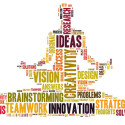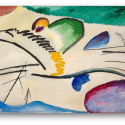It’s easy to underestimate the power of silence. In today’s noisy world, silence is something that isn’t easily mastered. People tend to feel uneasy when there’s a pause in the flow of sound or movement. Many feel the need to turn on the radio every time they get in their car. And when they’re home, they turn on the television or play music, or they look at their phone or iPad every free moment.
Silence, space, and stillness in rehearsal settings can be equally unnerving, but music performance experiences can help students learn the powerful influence of the gaps between sounds. If you’re a band or orchestra director, you have likely heard students look at a page of music and make a negative judgment about the worth of the experience because there are a lot of rests or long sustained notes. And you may have even chosen music with a lot of technical challenges because you’re more comfortable with the activity of all the notes on the page. But everyone can learn the value of silence.
Directors who fully engage with the musical momentum that can be created with the rests in music, the longer sustained notes, or the quiet before it starts and after it stops can provide deeper learning that positively impacts students for the rest of their lives. Miles Davis said that he always listened to what he could leave out. That kind of listening has incredible value.
I remember attending a semi-staged production of Mozart’s The Magic Flute several years ago. This opera has captivated audiences for more than 200 years, but. it was particularly enjoyable to experience it in an intimate setting with performers, orchestra, and action so close that it felt as if we were all part of the production.
While The Magic Flute’s overarching story speaks to the many tests we must face as we move through life, the real interpretive magic comes through reflection, awareness, and ever-deeper personal understanding of who we are as human beings. That experience doesn’t necessarily happen in the notes or dialog, but rather through the stillness that can be found in each of the character’s innermost thoughts and feelings.
The music is not in the notes, but in the silence between.
~ Wolfgang Amadeus Mozart
While performing artists spend hours expertly playing or singing the notes in music, they spend lifetimes perfecting the pauses between notes. That’s where the true artistry resides.
Mozart builds anticipation through his compositional technique to create dramatic pause, building tension and withholding resolutions. The pauses prolong the tension of the preceding buildup of tension creating a dynamic, charged silence. Silence is part of what gives the music such beauty and life. The world is a noisy place, and when students have an opportunity to experience deeper learning in music performance, they’ll soon discover the value of silence in other situations in their lives.
Music and silence combine strongly because music is done with silence, and silence is full of music. ~ Marcel Marceau
Are you a band or orchestra director? Are you unsure about how you can use this concept in your rehearsals? Take a look at my course—Transform Your Band and Orchestra Rehearsals: From Ordinary to Extraordinary — a course that’s intended to motivate you to open yourself to new possibilities, and to consider a deeper learning approach that helps students make connections beyond music to other situations in their lives.
Do you wonder how you can use this concept and others in your personal life and work? Take a look at my online course—Soft Skills to Kickstart Your Career: Little Known Benefits of Arts-Based Training to Catch the Eye of Employers—a course that’s designed to help you maneuver more confidently in today’s competitive environment and have more control over your future.
Patricia Hoy





